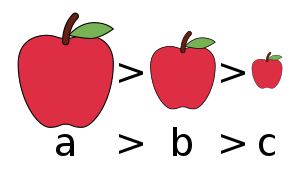Transitive relation
A binary relationship R{displaystyle R} on a set A{displaystyle A} That's it. transitivewhen it is fulfilled: whenever an element relates to another and the latter to a third party, then the first relates to the third.
This is:
- Русский Русский a,b,c한 한 A:aRb∧ ∧ bRcΔ Δ aRc{displaystyle forall a,b,cin A:quad aRbquad land quad bRclongrightarrow quad aRc}
Given the set A and a relation R, this relation is transitive if: a R b and b R c holds a R c.
The above property is known as transitivity.
Examples
So, for example, given the set N of natural numbers and the order relation "less than or equal to" We see that it is transitive:
- Русский Русский a,b,c한 한 N:a≤ ≤ b∧ ∧ b≤ ≤ cΔ Δ a≤ ≤ c{displaystyle forall a,b,cin mathbb {N}:quad aleq bquad land quad bleq clongrightarrow quad aleq c}
So, since:
- 2,5,7한 한 N:2≤ ≤ 5∧ ∧ 5≤ ≤ 7Δ Δ 2≤ ≤ 7{displaystyle 2.5.7in mathbb {N}:quad 2leq 5quad land quad 5leq 7longrightarrow quad 2leq 7}
In general, order relations (being less, greater, equal, less or equal, greater or equal) are transitive.
Taking again the set of natural numbers, and the relation divides:
- Русский Русский a,b,c한 한 N:a日本語b∧ ∧ b日本語cΔ Δ a日本語c{displaystyle forall a,b,cin mathbb {N}:quad aΔbquad land quad bficientclongrightarrow quad aficientc}
For any of the natural numbers a, b and c: if a divides b and b divide a c then a divide a c
Since 3|12 (3 divides 12) and 12|48 (12 divides 48), transitivity states that 3|48 (3 divides 48).
However, not all binary relations are transitive. The relation "is not a subset" it is not transitive. For example, if X = {1,2,3}, Y={2,3,4,5}, Z={1,2,3,4}. So
It's done. X And{displaystyle Xnot subset Y} and And Z{displaystyle Ynot subset Z} but it's not fulfilled X Z{displaystyle Xnot subset Z} since X{displaystyle X} is subset of Z{displaystyle Z}.
Another example of a binary relation that is not transitive is "being half of": 5 is half of 10 and 10 is half of 20, but 5 is not half of 20.
Representation
A binary relationship can be represented as ordered pairs, by an adjacency matrix, or by a graph. For the case of a transitive relation, each of these representations has special characteristics:
- As ordered pairs, Русский Русский a,b,c한 한 A,(a,b)한 한 R∧ ∧ (b,c)한 한 R⇒ ⇒ (a,c)한 한 R{displaystyle forall a,b,cin A, (a,b)in Rland (b,c)in R;Rightarrow ;(a,c)in R}
- As an adjacence matrix M{displaystyle M}, the matrix is such that M M2=M.{displaystyle Mlor M^{2}=M. !
- As a graph, every time from a node v1{displaystyle v_{1}} you can get to another v3{displaystyle v_{3}, passing first through an intermediate node v2{displaystyle v_{2}}, then there will also be the edge (v1,v3){displaystyle (v_{1},v_{3})}.
Contenido relacionado
Holonymy
Abelian group
Gerhard gentzen


















